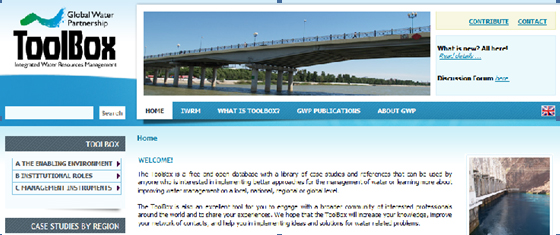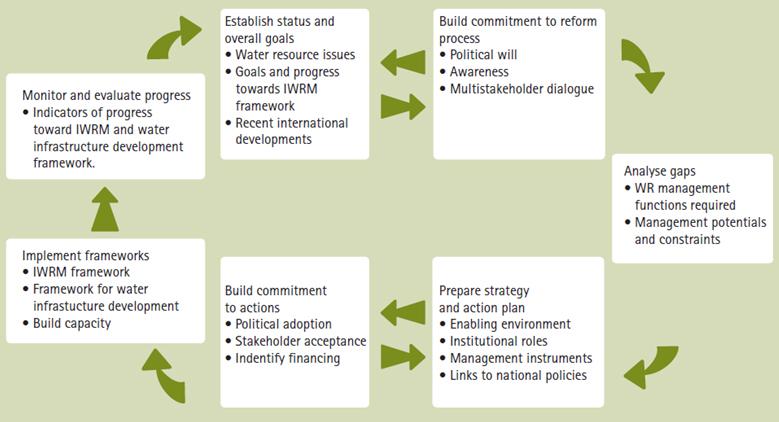Executive Summary
The Intention of GWP
GWP has committed itself to facilitating the sustainable management of water resources by fostering information exchange and helping to match needs for solutions to water problems with available tools, assistance and resources. In order to be able to work together towards a common objective, there is a clear need for a common understanding of what is meant by IWRM among all those involved. WRM is a complex field of water (related) issues, the biggest challenge is the consideration of all stakeholder levels in an appropriate way. It has to be ensured that IWRM plans on different action-levels are connected and adapted to each other, taking care of issues and problems on each level. Therefore, an instrument (or policy mix) will need to be developed, not only to meet different policy goals, but also to ensure that local or sectoral actors do not operate in narrowly self interested ways (Rees 2006).

Website of the GWP Toolbox. Source: GWP website
What is the GWP-Toolbox?
The GWP Toolbox comprises an organised collection of case studies, reference documents, external web sites and other supporting materials in water resources management, which have been submitted by various contributors and have been peer reviewed. The GWP Toolbox is intended to be an information exchange – experiences shared help to develop the body of knowledge which can enable all those engaged in water issues to work together to build water security and sustainable water for all. GWP has developed the Toolbox as a free access source of knowledge.
The Toolbox allows water related professionals to discuss and analyse the various elements of the IWRM process, and facilitates the prioritization of actions aimed at improving water governance and management. It aims to facilitate those professionals and specialists engage with a broader community for the solution of water related problems.
Content of the Toolbox
Altogether 54 different tools are presented in the GWP Toolbox. The tools are organised into three sections:
Firstly, those tools which create an “enabling environment” are presented; these are tools on water policies and their development, tools for the use in the development of water law; and finally tools which deal with financial resources to meet water needs.
The first section also constitutes the framework for other tools classified in the following section “institutional roles”. Here, tools regarding the form and function of institutions are presented, including the building of appropriate institutions and building capacity within these institutions.
Finally, the section “management instruments” presents several tools regarding the process of water management and planning. This section includes various tools: some for balancing water supply and demand, furthermore instruments for encouraging social change, tools for conflict management, instruments regarding the regulation of water, economic, market based instruments and finally tools in respect to information and knowledge management in IWRM.
The Toolbox is organised in a hierarchical manner with each tool embedded in the wider perspective of IWRM. The characteristics of each tool are described in the Toolbox such as to allow the user to select a suitable mix and sequence of tools that would work in a given country, context and situation. The problems faced by water managers are many and diverse, as are the political, social and economic conditions, so no blueprint for the application of IWRM can be given.
The GWP Handbook
In an effort to encourage a move towards more sustainable approaches to water development and management, the World Summit on Sustainable Development (WSSD) in 2002 called for all countries to craft IWRM and water efficiency strategies by the end of 2005. In 2003, the GWP conducted an informal survey to see how countries were progressing towards the action targets of the WSSD. The findings has shown that some countries are having difficulty seeing how an IWRM strategy helps them to further their social and economic development, while others are struggling in their efforts to get the process off the ground. Therefore, the GWP published this handbook for IWRM. The recommendations and lessons offered in the handbook, it is hoped, will address both types of obstacles.
Thus, the handbook is intended to support countries in their greater efforts to:
- Meet development goals, such as reducing poverty, increasing food security, fostering economic growth, protecting ecosystems.
- Tackle specific water challenges, such as controlling flooding, mitigating the effects of drought, expanding access to water and sanitation, and addressing increasing competition for water and water scarcity.
The document does not provide strict guidelines for crafting a strategy, rather, it seeks to provide countries with the knowledge they need to act on the WSSD action target in the way that is most useful for them.
The idea is not to create a traditional water plan covering water development and management actions to be taken over the course of a limited time span, but to develop a dynamic framework that will encourage better planning and decision making on an on-going basis.
The content of the handbook is structured into the following parts:
At first, the “concept” of IWRM is explained to ensure a deeper understanding of sustainable and integrated water management. In a second part, the “contents” of IWRM and its action fields are explained in more detail. The “process” and “action” parts encourage actors in the field of water management how to manage the ongoing process of an IWRM process and how to strategise a plan on the long run.

IWRM is a on-going process to respond to changing situations and needs. Source: GWP 2004
The Toolbox and the handbook serve as a guide for IWRM planning, implementation and monitoring. Basically, it works for everybody who is interested in water management and water governance or who is confronted with water management and water governance related issues. This includes trainers, practitioners, decision makers and experts of water related issues at all levels. Thus, the GWP Toolbox can be used as an instrument in training courses as well as an opportunity for an exchange of experiences for those who are involved in IWRM.
The Handbook on the other hand mainly advises lessons learnt on a national level, using experiences involved countries gained over the last years. Nevertheless, the concept as well as the process instructions can be used on every level of implementation.
Both, the toolbox and the handbook, serve as a valuable source of information and knowledge sharing for involved actors of IWRM. Certainly, the focus of GWP rather concentrates on decision makers at a wider policy level than on IWRM on a local level.
Integrated Water Resources Management (IWRM)
The paper is divided in two main parts: The first part puts forward a strong case for applying IWRM globally and defines the IWRM concept and process. The second part provides additional advice and guidance on how IWRM could be implemented in different conditions.
GWP (2000): Integrated Water Resources Management (IWRM). (= TEC Background Papers , 4 ). Stockholm: Global Water PartnershipCatalysing Change. A Handbook for Developing Integrated Water Resources Management (IWRM) and Water Efficiency Strategies
The concept, content and process of IWRM is explained in detail. Experiences from countries using IWRM over several years are incorporated in the handbook.
GWP (2004): Catalysing Change. A Handbook for Developing Integrated Water Resources Management (IWRM) and Water Efficiency Strategies. Stockholm: Global Water Partnership URL [Accessed: 03.05.2010]Urban Water and Sanitation Services. An IWRM Approach
Integrated Water Resources Management (IWRM)
The paper is divided in two main parts: The first part puts forward a strong case for applying IWRM globally and defines the IWRM concept and process. The second part provides additional advice and guidance on how IWRM could be implemented in different conditions.
GWP (2000): Integrated Water Resources Management (IWRM). (= TEC Background Papers , 4 ). Stockholm: Global Water PartnershipCatalysing Change. A Handbook for Developing Integrated Water Resources Management (IWRM) and Water Efficiency Strategies
The concept, content and process of IWRM is explained in detail. Experiences from countries using IWRM over several years are incorporated in the handbook.
GWP (2004): Catalysing Change. A Handbook for Developing Integrated Water Resources Management (IWRM) and Water Efficiency Strategies. Stockholm: Global Water Partnership URL [Accessed: 03.05.2010]Effective Water Governance: Learning from Dialogue
This document is a status report prepared for presentation at the 3rd World Water Forum in Kyoto, Japan, March 16-23, 2003. This document brings together the experience gained after conducting the Dialogue on Effective Water Governance over the last year.
GWP (2003): Effective Water Governance: Learning from Dialogue. Stockholm: Global Water Partnership URL [Accessed: 03.05.2010]Poverty Reduction and IWRM
This paper focuses on the implications for poverty reduction of taking an integrated approach to water resources management.
GWP (2003): Poverty Reduction and IWRM. (= TEC Background Papers , 8 ). Stockholm: Global Water Partnership URL [Accessed: 03.05.2010]Effective Water Governance
This paper discusses water governance in a coherent way, and shows relations to IWRM and development.
ROGERS, P. HALL, A.W. (2003): Effective Water Governance. (= TEC Background Papers , 7 ). Stockholm: Global Water Partnership URL [Accessed: 03.05.2010]Community And Non-Govermental Organisation (NGO) Partnership in Highland Catchment Managment in Malaysia
This case study from Malaysia describes a community-NGO partnership in addressing water resource and catchment management, thus typical IWRM issues, and the significant milestones achieved as well as the challenges faced.
GWP (2005): Community And Non-Govermental Organisation (NGO) Partnership in Highland Catchment Managment in Malaysia. Global Water Partnership URL [Accessed: 03.05.2010]INDIA - Community Watershed Management Socities in Rrual India
This case study highlights several IWRM lessons from recent research in the Shiwalki Hills, Haryana, India. Specifically, two villages are examined to determine how social, political, and environmental factors drive the institutions which manage these common pool resources.
GWP (n.y): INDIA - Community Watershed Management Socities in Rrual India. Global Water Partnership URL [Accessed: 03.05.2010]Eritrea: Vital aspects of the IWRM planning process
Eritrea began the process towards IWRM development at the end of 2005. With support of the government and commitment of partners, this water sector situation analysis report was drafted in July 2006. Five working groups worked on 18 thematic strategic areas. The findings and results are presented in this paper.
GWP (2006): Eritrea: Vital aspects of the IWRM planning process. Global Water Partnership URL [Accessed: 03.05.2010]GWP IWRM ToolBox
The website of GWP contains the toolbox as a web-based learning tool itself and additionally all publications by GWP. Topics of IWRM, Good Water Governance and many more IWRM related issues are discussed in a very comprehensive way. A very extensive collection of high-quality papers are available in English, French, Spanish and Russian. The site also contains a very extensive collection of case studies
